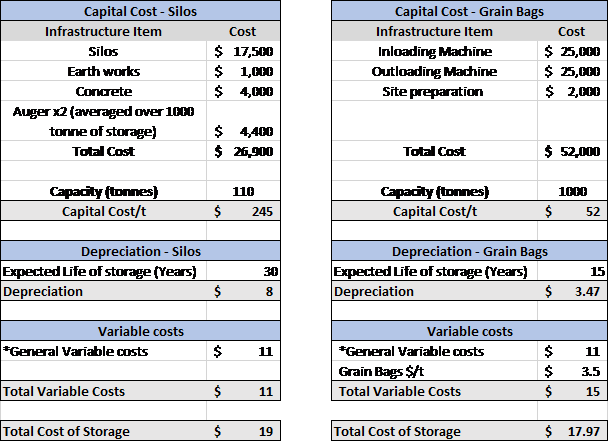On-farm grain storage options
- By: "Farm Tender" News
- Cattle News
- Apr 09, 2020
- 1256 views
- Share

By Tim Bateman, Business Consultant
Things to consider when deciding what form of on-farm storage suits you include:
• How long am I planning on storing the grain?
• Is the storage simply for harvest logistics/timeliness?
• How will I manage grain pests?
• Will I require aeration or drying facilities?
• Is the ability to either in-load or out-load at short notice and in a timely manner important?
Once these points have been addressed, then it’s important to analyse the economics of the grain storage options that best suit your operation. These could include grain bags, bunkers, sheds, unsealed silos, sealed silos or a combination of these storage methods.
Most will agree that steel silos provide the best longer term storage options, confirmed by the increasing numbers of silos located on-farm. However, if silo space is full or you’re managing harvest logistics, then grain bags in the paddock can be a viable option.
Storage direct from the chaser bin and without the need for a truck can increase harvest efficiency. Without the need for trucks to shift grain then it’s the capacity of the harvesters that determines harvest efficiency.
So, is short term storage using grain bags economical and what is the cost comparison? Figure 1 shows ‘Storage Cost Comparison’ for silos and grain bags.
Figure 1: Storage Cost Comparison

*Assumed general variable cost of $11/t (in-load/out-load time, opportunity cost of stored grain, insect treatment, etc)
Source: ORM Pty Ltd
When using estimates as shown in Figure 1, grain bags have a low capital cost of $52 per tonne compared to $245 per tonne for 110 tonne silos. However, the capital cost of grain bags becomes approximately half that of silos when assuming silos have double the life of the grain bag in-loading and out-loading machines.
Comparison of variable costs is similar, but with addition of the plastic bag cost for the grain bags.
The cost of trucking grain from paddock to silo has not been included, likewise the extra labour to in- and out-load grain bags is not included. For this comparison these costs are assumed to cancel each other.
In addition to cost comparison, other factors that need to be considered when determining grain storage options include the:
• Opportunity to increase harvest efficiency by using in paddock storage
• Availability of trucks to keep grain away
• Need for longer term storage
• Pest control using fumigation
• All weather access for marketing.
Most growers are planning to increase steel silo storage on the farm, however many now use grain bags to assist with harvest logistics. On-farm storage using grain bags is an alternative to warehousing in the bulk handler system, and is an option used by some growers who are looking for flexible market options.
Plan your harvest to be finished in 21 days. On-farm grain storage should be treated as part of an overall plan to achieve maximum harvest efficiency.
Here’s hoping for good spring rains, then harvest logistics will be important. Grain bags provide an efficient option to get the grain undercover but require more labour. So make a plan in advance of harvest to ensure grain storage is not an issue during harvest.









Share Ag News Via